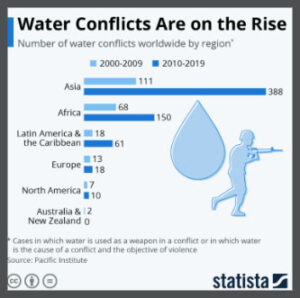
Water is one of life’s essential needs.
However, the water crisis is becoming more common around the world as billions of people suffer from a lack of access to clean water, sanitation, and hygiene.
With crisis comes conflict.
The Pacific Institute has identified three different types of conflict that can be distinguished into three different types.
“Trigger: Conflicts over control of water; economic or physical access to water or even water scarcity trigger violence.
Weapon: Water resources or water systems are used as an instrument or weapon in a violent conflict.
Casualty: Loss of water resources or water systems due to becoming intentional or incidental targets of violence.”
The number of water conflicts is increasing with Asia seeming to be the hotspot. Violent border conflict over access to water resources in the region between Tajikistan and Kyrgyzstan caused around 41 deaths and over 200 injuries in 2021 alone.
Data from the Pacific Institute shows that Asia has the highest number of conflicts in absolute terms and the strongest recent growth in conflicts.
The largest and most important rivers in Asia are controlled by China – which is why unrest is also growing in India and Bangladesh. Experts believe these conflicts will increase in the coming years.
Ethoipia’s plan to build a dam at a cost of more than five billion dollars is leading Africa to become the world’s second-largest water conflict region. This plan to dam up the Blue Nile, flowing through Ethiopia, has recently caused a great deal of trouble and particular consternation in downstream Egypt, where the Nile water has been the country’s livelihood for centuries
Despite water being one of life’s essential needs, it seems it could also become one of life’s greatest weapons.
Bronwyn Reid | May 2022
